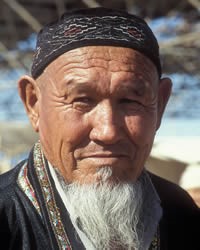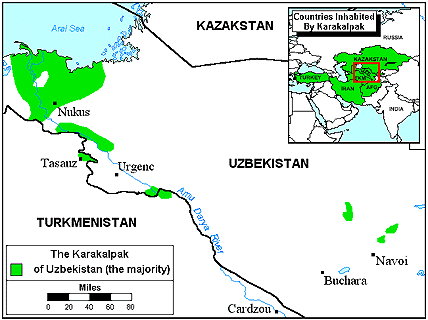The Karakalpaks ("Kara" meaning black, and "Kalpak" meaning hat) live primarily in northwestern Uzbekistan. The Karakalpaks emerged as a confederation of tribes at some time in the 15th or 16th centuries. They are genetically highly heterogeneous. During the 1500s, they became virtually independent, although they were not united. Their independence was short lived. Over the next 200 years, they became subjects of the Dzungarians, the Bukharans and the Kazakhs. The Dzungarians forced them to flee in two directions. One group, the upper Karakalpaks, went up the Syr Darya River to the Ferghana Basin. The second, the lower Karakalpaks, moved closer to the Aral Sea. Before the Russian Revolution of 1917, the Karakalpaks were a loose alliance of semi-nomadic tribes. However, in the 1920s, the Karakalpak republic was established in Uzbekistan, a region that is extremely dry and rarely receives more than 4. 5 inches of rain a year. The Karakalpak tribes are divided into clans called uru. The uru are further sub-divided into family groups called koshes. The members of a koshe are the descendants of a common male ancestor. They share land and are extremely loyal to each other. The Karakalpak language is divided into two dialects: northeastern, which is very similar to Kazakh, and southwestern, which is more like Uzbek. Their language had no written script until 1930. Though most Karakalpak people live in Uzbekistan, there are smaller populations in Russia, Turkey, Iran, Kyrgyzstan, Kazakhstan, Turkmenistan, and Afghanistan.
The Karakalpaks in Iran are generally poor, and unemployment is high, but people do what they can to make a living, working on their vegetable plots and gardens, fishing, selling at markets, raising livestock, doing casual or seasonal jobs, etc. There is no social security system, just a network of local committees who can provide temporary support for the severely destitute. Karakalpak societies are patrilineal, which means that the line of descent is traced through the males. Large families are the ideal, and the nuclear family is composed of as many as four generations in the same household. The Karakalpaks believe that families who share meals together will stay close. The majority of Karakalpak boys and girls receive schooling up to the age of 15 or 16. Although school attendances have fallen since independence in 1991, the great majority of both boys and girls are still enrolled in primary schools. Literacy rates are high. Girls often marry at age 16 or 17 right after they finish school. Rites of passage are important to the Karakalpak people. When a baby is born, a Karakalpak mother will invite all family members to come meet the baby. They embrace marriages as the way to merge two families and keep their family lines alive. They celebrate weddings for days with music, dancing, speeches, and feasts. When someone dies, there are rituals that the bereaved family must do while mourners come to extend their sympathy. A Muslim mullah will lead the procession to the graveyard where he utters the final prayers. The family is responsible for burying the deceased.
The Karakalpaks are Sunni Muslims of the conservative Hanafite branch. "Sunni," is derived from the Islamic term, sunnah, which means "well-trodden path. " Sunnis believe that the correct path is that of the majority. Sunnis expect conformity to the majority belief in religious and political matters. The Karakalpak people are noted for their participation in the Sufi sect of Islam. Some Sufi Muslims are known for practicing self-hypnosis which is induced by frenzied dancing and chanting.
Very few Karakalpaks have ever heard the gospel; among those who have heard, very few have responded. There are only a few reported church members among the Karakalpak people in any country where they reside.
Pray for the Lord to thrust out workers who will be compelled to nurture a movement to Christ among the Karakalpak people. Pray for a Jesus movement among the Karakalpaks in Iran that will spread joy, peace, reconciliation, and salvation to other peoples in Central Asia. Pray for the Karakalpak culture to be renewed and enhanced by a work of the Holy Spirit and shaped into a God-centered and God-honoring mold. Pray for the Holy Spirit to move among Karakalpak family and community leaders to seek his face and enjoy his blessings. Pray that soon the Karakalpak people will have faith that will lead them to live honorable lives that will draw others to the Savior.
Scripture Prayers for the Karakalpak in Iran.
| Profile Source: Joshua Project |












